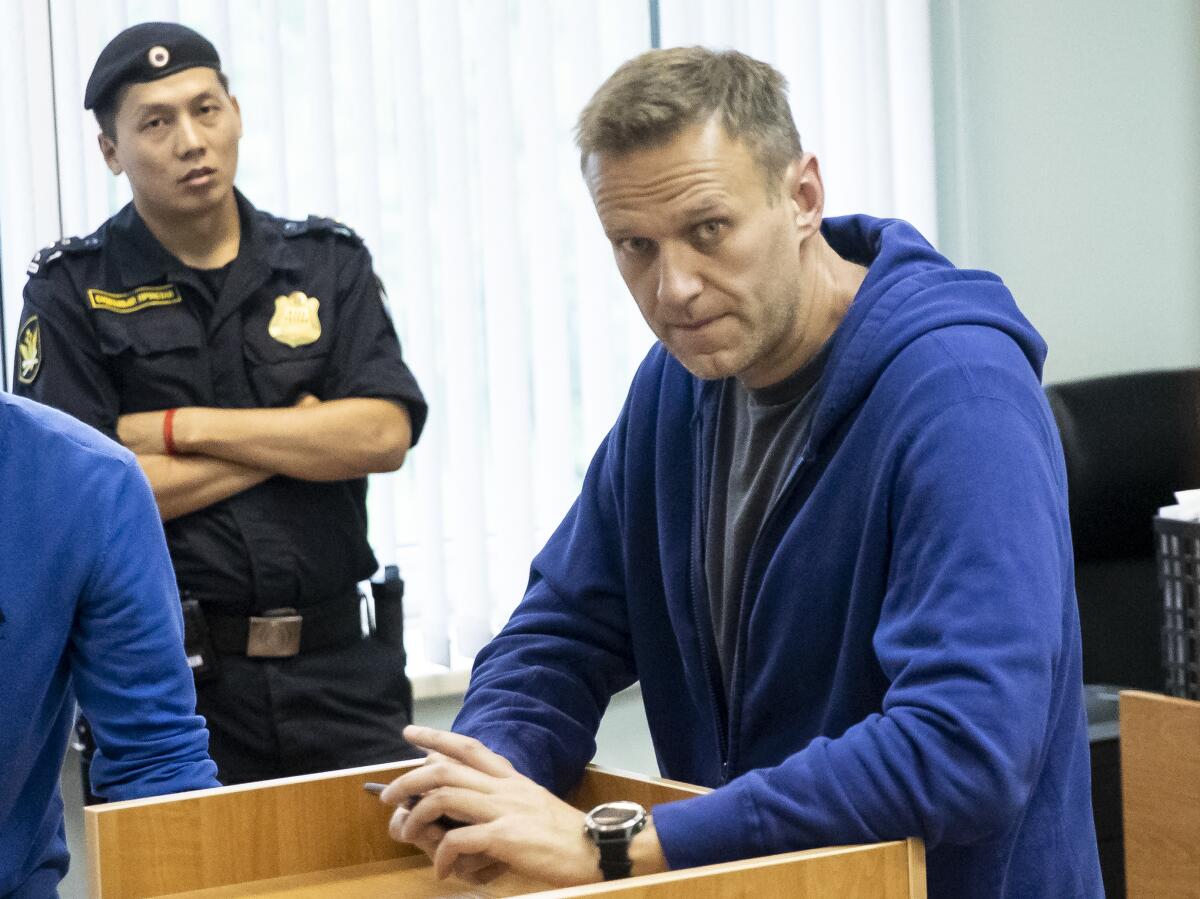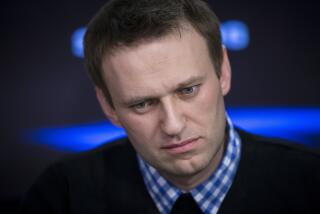Russian opposition leader released from hospital amid speculations of poisoning

MOSCOW — Russian opposition leader Alexei Navalny was released from a Moscow hospital and sent back to jail Monday after being treated for a severe rash and eye irritation his personal doctor said could be the result of a poisoning.
Navalny was rushed from a Moscow detention center — where he is serving a 30-day term for organizing an unsanctioned demonstration — to the hospital after experiencing an acute allergic reaction. He had a red rash on his face, neck and body and discharge from his eyes, according to Kira Yarmysh, his spokeswoman. She said at the onset of his condition that Navalny had no known allergies.
On Monday, the hospital said Navalny was in satisfactory condition and concluded his ailment could have been an allergic reaction to laundry detergent used at the detention center.
Navalny’s personal ophthalmologist, Dr. Anastasiya Vasilyeva, said she had been allowed to see him and later posted on social media that she was concerned that he might have been exposed to an unidentified “toxic agent.”
She advised against sending Navalny back to the place where he was possibly poisoned, and where the substance could remain, she said.
In an interview with the independent Rain TV, Vasilyeva said she plans to send his T-shirt and a sample of his hair to a lab for independent testing.
In a blog post written after his release, Navalny described how a red skin rash began developing on Saturday, the same day as the protests in Moscow. His cellmate took a look at Navalny’s face Sunday morning and urged him to go to the hospital immediately.
The hospital doctor’s diagnosis that it was an allergic reaction to the soaps used in the jail seemed odd to him, he wrote. Navalny has served several terms in jail, even spent 10 days in the same cell just two weeks ago, he wrote. He’s never had an allergy in his life, let alone during any of his stints in jail, he said.
“Let me put it bluntly: Do I think that they could poison me?” he wrote.
Initial reports of Navalny’s hospitalization came at a time of high tension between anti-government demonstrators and the Kremlin. The conflict rose after the Moscow elections committee denied applications from independent candidates for a City Council election to be held in September.
For two weekends in a row, tens of thousands of demonstrators have taken to the streets to demand that the candidates be allowed on the ballot.
The protests intensified on Saturday, when police arrested more than 1,300 protesters and violently beat other demonstrators with truncheons in the center of Moscow.
Human rights organizations have expressed concerns about the police’s heavy-handed response to the demonstrators. The U.S. Embassy in Moscow criticized the violent crackdown for its “disproportionate” use of police force.
Moscow Mayor Sergei Sobyanin had warned protesters ahead of the unsanctioned rally that participants would be prosecuted. Navalny was sentenced just days before Saturday’s protests. Several opposition candidates are now facing a possible legal fight on accusations they organized demonstrations that obstructed the work of the election commission.
On Sunday night, police detained 28 protesters demonstrating outside of the Moscow hospital where Navalny was being treated.
Speculation that Navalny could have been poisoned sparked alarm in Russia. Last year, the United Kingdom and other Western governments accused the Kremlin of orchestrating the poisoning of a former KGB agent and his daughter, who were living in England, with a Soviet-made nerve agent investigators identified as Novichok. The Kremlin has denied the allegations and said the U.K. has not allowed Russia to participate in an international investigation into the incident.
Navalny’s blog post explains why he believed the Russian authorities may have poisoned him, noting several instances of the recent alleged poisonings of activists, as well as the Skripal case in the U.K. Then there was the case of Ivan Golunov last month, when Moscow police reportedly planted narcotics on the investigative journalist and arrested him. The Golunov case sparked street protests in Moscow. Eventually the charges were dropped.
“I can say one thing with confidence: There are really rather stupid dudes in power in Russia,” he wrote. There’s no need to look for a secret meaning or a rational reason from the Russian authorities behind all these incidences, he said. “In reality they are just stupid, angry and obsessed with money.”
Navalny is a fierce critic of Russian President Vladimir Putin and Kremlin policy. His Anti-Corruption Foundation has done extensive investigations into government corruption that have accused high-ranking officials including Prime Minister Dmitry Medvedev and Kremlin spokesman Dmitry Peskov of enjoying lavish lifestyles funded by Russian taxpayers. His calls for anti-government protests in the past have brought thousands to the streets across the country, many of them resulting in harsh police crackdowns and mass detentions. Navalny has served several 30-day terms for organizing unsanctioned rallies during the last two years.
In 2018, he was barred from running against Putin’s re-election bid because of a past fraud conviction Navalny claims was politically motivated.
Two years ago, Navalny suffered eye damage when an assailant splashed a commonly used green antiseptic called zelyonka in his face. The attack left him with only 80% of his eyesight, which he has slowly regained since the attack.
Opposition leaders are calling for another demonstration on Saturday to continue putting pressure on the Kremlin to allow independent candidates on the September ballot. The Moscow City Council has 45 seats and is currently dominated by the ruling United Russia party.
The Kremlin has not commented on Saturday’s protests or Navalny’s condition. Russian state television over the weekend barely mentioned the events and instead focused on Putin’s dive to the bottom of the Gulf of Finland to explore a sunken World War II Soviet submarine. Some independent media outlets covering the demonstrations live were visited by the police on Saturday, and their editors called in for questioning.
More to Read
Sign up for Essential California
The most important California stories and recommendations in your inbox every morning.
You may occasionally receive promotional content from the Los Angeles Times.











